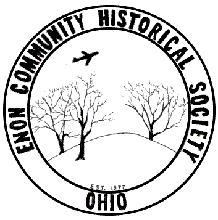Enon Log Home

In the Beginning
Early settlers of this area built log homes from resources available. Many of these homes were temporary until a “modern” home could be built. Many others were sided over soon after construction. Round log homes were usually temporary ones and were generally called cabins. The hewn, square logs were more finished and flat, and a good foundation for siding that may be put on subsequent to construction. These were called log houses.
On the Records
The census and tax records of Clark County show this log house, maintained by the Enon Community Historical Society, was moved to lot # 69 of the Baker addition early in 1851 by John Gallagher. It appears the house was constructed earlier at another site.
Details
There was evidence of three fires in the log house between 1851 and 1940. The house was severly damaged in 1859, but was repaired in 1867. At that time it increased in value probably as the second floor was added. The following years, additional rooms, plaster and siding were added. The original log house was a one room structure with a stone fireplace. The fireplace was not rebuilt when it was moved to Baker addition in 1851. The opening was covered with handmade accordion lath and an inside chimney was constructed of brick. The current fireplace consists of stones collected from the basement of the original building and the entire building is 16 feet by 18 feet with steeple notched logs, typical of the early 19th century.
Today
Last owned by Jerry and Barbara Brown, who donated the structure to the historical society in 1978, the structure was moved by the society with the help of CETA workers. One second floor log was removed (it was damaged) and the house became shorter, fitting into the neighboring roof lines. The loft or second floor is shorter now, but earlier may have been used for sleeping quarters, storage, drying items in the winter months. The walls were originally white washed inside and outside (remnants may be seen). The lathe from filler plaster wall areas is shown hanging near the rope bed. The home was orginally located at 55 South Harrison Street. The last owners, Browns, used it as a Bicycle Shop. Former owners, besides Gallagher, include Robert S. Little, David Cross, Melyn Layton, William Cox, Michael Greaser, Joseph Holycross, Michael Rule, David Crimmins, Gordon Adkins. The Enon Village Council paid for the concrete slab and liability insurance and the society dedicated it in 1980.
The interior reflects a simple life in the early 19th Century Ohio. The typical rope bed (1830, Pennsylvania, poplar wood) has a collection of feather tick mattresses, pillows, early quilts and coverlets. The rope cradle is very unusual and from Virginia. The accessories for daily living include a pie safe, iron cooking utensils, pottery dishes, early side chairs, wash tub and scrub board (reproduction), and assorted rugs. An 1850 blanket chest is at the foot of the bed and used to store clothing and blankets.
Featured item is an 1850 – 1861 Wheeler Wilson sewing machine. The best sewing machine was invented in 1846, so this machine was not much later than when the best machines were available. It makes a straight stitch, has a glass foot and sews sideways.
Guides and representatives on special occasions wear typical clothing of the early Ohio period: short gowns, chemises, petticoats, bonnets, aprons and work smocks (for the men).
Tours and open houses are held periodically and by appointment. A small fee is charged for groups not located in the Greenon School District. For further information call the Enon Community Historical Society, 937-864-7080
